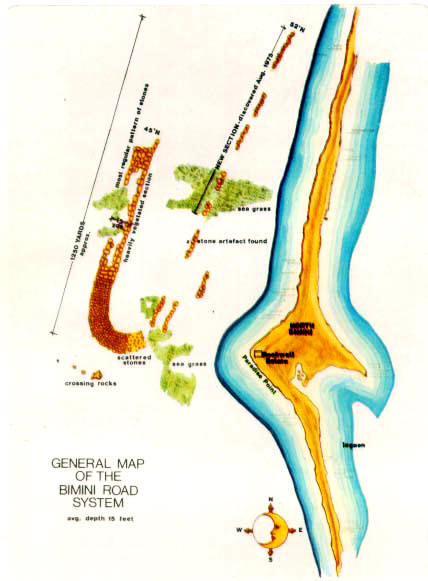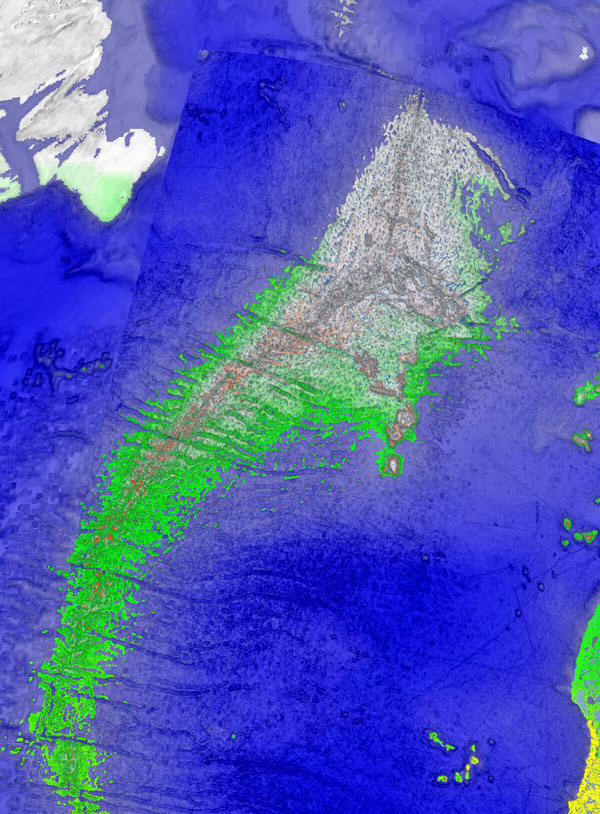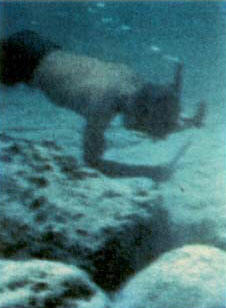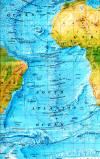|

In 1940 the American psychic healer and prophet
Edgar Cayce predicted that
Atlantis would 'rise again' in 1968 or 19969. So, in 19968, when it seemed
that the site of the world's most famous lost land had finally been located
in the eastern Mediterranean, news that underwater vast building off the
Bahamas shook Atlantist everywhere. The question of Atlantis was reopened.
Could this be Poseidia, described by Cayce as the 'western' section of
Atlantis? Were Plato and the other Atlantists right after all when they
placed their lost civilization way out in the Atlantic Ocean?
In 1968 two commercial pilots flying over the Bahamas spotted what appeared
to be several underwater buildings coming to the surface. The pilots made
their sightings just off the coast of Bimini and photographed the underwater
formations from the air. Their discovery was immediately hailed by some as
the fulfillment of a 28 year-old prophecy concerning the reappearance of
Atlantis. Indeed one of the pilots had been keeping a lookout for underwater
structures while flying his regular assignments because he believed Atlantis
was about to reemerge from the Atlantic in this very area.
The man concerned is a member of the Association for Research and
Enlightenment, an organization based in Virginia Beach, VA, which is
dedicated to the study of the teachings and "psychic readings" of the late
Edgar Cayce, the "sleeping prophet" and psychic healer. Between 1923 and
1944 Cayce made numerous references to Atlantis in the course of trance
interviews concerning the alleged former lives of the people who consulted
him. These interviews were recorded verbatim, and much of the material about
Atlantis has been published in a book called Edgar Cayce on
Atlantis, by
Cayce's son Edgar Cayce. It includes this prediction, made in June 1940:
"Poseidia
will be among the first portions of Atlantis to rise again. Expect it in
''68 and '69; not so far away!"
According to the Cayce readings, Poseidia was the "western section of
Atlantis," and the area off Bimini is the highest point of this sunken land.
|

Map of Bimini Road drawn after aerial and
underwater surveys carried out by the Poseidia
75 expedition, sponsored by the
A.R.E. The
road is magnified to approximately twice its
actual size in relation to the island of Bimini.
Shaped roughly like a letter J, it is some three
quarters of a mile long and composed of huge
stone blocks, often 15 feet square. On this map,
the X marking the discovery of a stone artifact
relates to a fragment of what appeared to be
tongue and groove masonry discovered on the
Poseidia 75 expedition by one of its member -
Dr. David Zink. |
So the
A.R.E. is naturally delighted about the underwater find in the
Bahamas, just where and when the famous prophet said something would appear.
Until this and similar discoveries have been thoroughly explored, we have to
admit that There may yet have an equally plausible rival for the title of
Atlantis, right where most people always considered the long-lost continent
to be - in the Atlantic.
In his book 'The Mystery of Atlantis' Charles Berlitz comments that,
"Other
underwater ruins have subsequently been found near other Caribbean islands,
including what appears to be an entire city submerged off the coast of
Haiti, and still another at the bottom of a lake. What appears to be an
underwater road (or perhaps a series of plazas or foundations) was
discovered in 1968 off north Bimini beneath several fathoms of
water. From these numerous findings, it would appear that par of the
continental shelf of the Atlantic and Caribbean was once dry land, sunk
or flooded during a period when man was already civilized".
Not everyone accepts these underwater features as being of man-made origin.
The so-called "Bimini road" is dismissed by skeptics as nothing more than
beach rock that just happens to have produced an unusual effect. Berlitz and
Dr. Manson Valentine, the American archaeologist and oceanographer who
discovered the "road", do not agree.
"It should be pointed out." writes
Berlitz, "that beach rock does not form great blocks which fit together in a
pattern, that haphazardly splitting rock does not make 90- degree turns, nor
does it normally have regularly laid-out passageways running between
sections of it. Nor, above all, are 'natural' beach rocks, lying on the
ocean floor, likely to be found supported by stone pillars precisely placed
beneath them!"
Other sightings made off Bimini, at distances up to 100 miles from the
shore, include what appear to be vertical walls, a great arch, and pyramids
or bases for pyramids under the sea. some 10 miles north of Andros, another
island in the Bahamas, pilots have photographed formations on the seabed
that look like great circles of standing stones, reminiscent of Stonehenge.
Off the coasts of eastern Yucatan and British Honduras seemingly man-made
roads stretch far out to sea, and off Venezuela a 100-mile 'wall' runs along
the ocean bottom. However, geologists have declared many of these to be
natural features, and deem the Venezuelan wall "too big to be considered
man-made". According to Berlitz, the Russians have explored an underwater
building complex covering over 10 acres of the sea floor north of Cuba, and
the French bathyscape Archimede has reported sighting flights of steps
carved in the steep continental shelf off northern Puerto Rico.
Do these intriguing finds indicate that Atlantis was, after all, in the
Atlantic? it seems we must keep an open mind until they have been
investigated more thoroughly. Meanwhile, let us take a fresh look at the
Atlantic Ocean to see if the theory of continental drift might still leave
room for a missing continent there. When a computer was used to reassemble
the continental jigsaw, the fit across the Atlantic was found, with some
adjustment, to be fairly satisfactory. But that picture does not take
account of a fascinating underwater feature known as the mid-Atlantic Ridge.
This mountainous ridge, nearly two miles high and hundreds of miles wide,
runs in an S-curve down the Atlantic midway between the Americas and Africa
and Europe, following the contours of those continents and marking its
course above water with a number of islands, such as the Azores,
Ascension
Island, and Tristan da Cunha.

As early as 1883 Ignatius Donnelly suggested that the mid-Atlantic Ridge was
a remnant of Atlantis. But most modern geologists and oceanographers
consider that, far from being the relic of a continent that sank beneath the
sea, the ridge was forced upward from the ocean floor, probably by volcanic
activity. One theory is that as the continents drifted apart they produce a
huge fault line that is a center of earthquake and produce a huge fault line
that is a center of earthquake and volcanic action. Some of the earth's
molten center has erupted through this crack and built up into a ridge, even
rising above the waves in several places. However, there is evidence that
this explanation may have to reviewed before too long.
|

A diver taking part in A.R.E.s Poseidia
75 expedition to Bimini in the Bahamas
examines an encrusted marble column
found about a mile south of the Bimini
Road. In 1968, what appeared to be a
vast underwater road was discovered
off Bimini, and the next year the columns,
of which this is one, were found. |
Seabed cores taken from the mid-Atlantic Ridge in 1957 brought up freshwater
plants from a depth of two miles. And in one of the deep valleys, known as
Romanche, sands have been found that appear to have been formed by
weathering when that part of the ridge was above water level. In a 1969 a
Duke University research expedition dredged 50 sites along an underwater
ridge running from Venezuela to the Virgin Islands, and brought up granitic
rocks, which are normally found only on continents. Commenting on this
discovery, Dr. Bruce Heezen of the Lamont Geological Observatory said:
"Up
to now, geologists generally believed that light granitic or acid igneous
rocks are confined to the continents and that the crust of the
earth beneath the sea is composed of heavier, dark-colored
basaltic rock... Thus, the
occurrence of light-colored granitic rocks may support an old theory that a
continent formerly existed in the region of the eastern Caribbean and that
these rocks may represent the core of a subsided, lost continent."
A recent report on the nature of the Atlantic seabed appears to confirm that
there is at least part of a former continent lying beneath the ocean. Under
the heading "Concrete Evidence for Atlantis?" the British Journal New
Scientist of June 5, 1975 reported, "Although they make no such fanciful
claim from their results as to have discovered the mythical mid-Atlantic
landmass, an international group of oceanographers has now convincingly
confirmed preliminary findings that a sunken block of continent lies in the
middle of the Atlantic Ocean. The discovery comes from analyzing dredge
samples taken along the line of the Vema offset fault, a long east-west
fracture zone lying between Africa and South America close to latitude 11º "N".
The report goes on to state that in 1971 two researchers from the University
of Miami recovered some shallow-water limestone fragments from deep water in
the area. Minerals in the limestone indicated that they came from a nearby
source of granite that was unlikely to occur on the ocean floor. More
exhaustive analysis of the dredge samples revealed that the limestones
included traces of shallow-water fossils, implying formation in very shallow
water indeed, a view confirmed by the ratios of oxygen and carbon isotopes
found in the fragments. One piece of limestone was pitted and showed
evidence of tidal action.
The researchers believe that the limestone dates from the Mesozoic era
(between 70 and 220 million years ago) and forms a cap "on a residual
continental block left behind as the Atlantic spread out into an ocean." the
New Scientist observes that
"The granitic minerals could thus have come from
the bordering continents while the ocean was still in it infancy. Vertical
movements made by the block appear to have raised it above sea level at some
period during it's history.
It would therefore seem that there is a lost continent in the Atlantic, but
unfortunately for Atlantists, it evidently disappeared long before man
appeared on earth. Most scientist remain convinced that there is no
likelihood of finding the Atlantis described by Plato in the area of the
mid-Atlantic Ridge. As L. Sprague de Camp comments in his Lost Continents,
nearly all of the ridge, except for the small and mountainous Azores region,
is under two or three miles of water, "and there is no known way to get a
large island down to that depth in anything like the 10,000 years required
to fit in with Plato's date for the sinking of Atlantis." He also points to
a report published in 1967 by Dr. Maurice Ewing of Columbia University, who
announced that "after 13 years of exploring the mid-Atlantic Ridge, he had
"found no trace of sunken cities."
Atlantists reply that Dr. Ewing could have been looking in the wrong places,
or perhaps too close to the center of the destructive forces that plunged
Atlantis into the ocean. Some Atlantists have suggested that the original
Atlantic landmass broke up into a least two parts, one of which sank long
after the other. Perhaps Plato's Atlantis was a remnant of the continent
that oceanographers now appear to have detected in the Atlantic, and perhaps
it was not submerged until very much more recent times. The bed of the
Atlantic is, after all, an unstable are and one that has given birth to
numerous islands, then swallowed them up again. In 1811, for example,
volcanic activity in the Azores resulted in the emergence of a new island
called Sammrina, which shortly sank back again into the sea. In our own
time, the island of Surtsey, 20 miles southwest of Iceland, has slowly risen
from the ocean. Surtsey was formed during a continuous underwater eruption
between 1963 and 1966.
If Atlantis did exist in the Atlantic above the great fault line that runs
between the present continents, it would certainly have been plagued by
earthquakes and volcanic eruptions. Is it mere coincidence that Plato should
have situated his lost continent in an ocean that does apparently contain
such a continent, and in an area subject to the very kind of catastrophe he
describes? Atlantists think not.
|

NORTHERN HEMISPHERE |
|

SOUTHERN HEMISPHERE |
On the other hand, there are some Atlantists who believe that the
destruction of Atlantis was brought about not by geological events but by a
man-made disaster, such as a nuclear explosion. According to the
Cayce
readings, the Atlanteans achieved an astonishingly high level of technology
before the continent sank, around 10,000 B.C. They invented the laser,
aircraft, television, death rays, atomic energy, and cybernetic control of
human beings, and it was the misuse of the tremendously powerful natural
forces they had developed that caused their destruction.
Cayce is best-known for his apparent ability to diagnose illness even in
people whom he had never met. This ability was tested by a group of
physicians from Hopkinsville and Bowling Green, Kentucky. They discovered
that when Cayce was in a state of trance, it was sufficient to give him the
name and address of a patient for him to supply a wealth of information
about that person, often drawing attention to medical conditions of which
the physicians were then unaware, but that subsequent tests on the patient
proved to be correct.
This work alone would appear to justify the
description of Cayce as America's most talented psychic. And if one aspect
of his clairvoyant powers could prove so successful, it seems reasonable to
give a fair hearing to other psychic statements he made, however, fantastic.
Cayce's sons, who help run the organization set up to study his work, admit
that their life would be far simpler if Edgar Cayce had never mentioned
Atlantis. Hugh Lynn Cayce comments:
"It would be very easy to present a very
tight evidential picture of Edgar Cayce's psychic ability and the
helpfulness of his readings if we selected only those which are confirmed
and completely validated. This would not be fair in total, overall
evaluation of his life's work. My brother and I know that Edgar Cayce did
not read Plato's material on Atlantis, or books on Atlantis, and that he, so
far as we know, had absolutely no knowledge of this subject. If his
unconscious fabricated this material or wove it together from existing
legends and stories in print or the minds of persons dealing with the
Atlantis theory."
Edgar Evans Cayce makes the comment that,
"unless proof of
the existence of Atlantis is one day discovered, Edgar Cayce is in a very
unenviable position. On the other hand, if he proves accurate on this score
he may become as famous an archaeologist or historian as he was a medical
clairvoyant."
If, as his sons and thousands of followers believe, Edgar Cayce's readings
were supernormal and not the product of reading the works of others, it is
certainly an intriguing case. There are, for example, some fascinating
similarities between Cayce's descriptions of Atlantis and those of
occultists such as Madame Blavatsky, Rudolf Steiner, and W. Scott-Elliott,
including references to the Atlanteans telepathic and other supernormal
powers, their advanced technology, their moral disintegration, and the civil
strife and misuse of their powers that finally caused their demise. Cayce's
readings also mention
Lemuria, or Mu. Either
Cayce was psychically readings
the works of these earlier writers, or he - the they - really were 'tuning
in' to the past.
Whatever the result of future investigations around the splendid temples and
palaces of Crete, or in the depths of the Thera basin, there will still be
people who continue to look for convincing case for the identification of
Plato's Atlantis with the Minoan civilization of the Aegean, but their
opponents argue that the existence of such a civilization - however striking
it similarities with Atlantis - does not preclude the existence of an even
great civilization in the Atlantic. The finds in the Bahamas remain to be
verified, and the discovery of what appears to be a submerged continent in
the Atlantic adds a new dimension to the Atlantis mystery.
Whatever prompted Plato to write about Atlantis, he could never have dreamed
that he would start a worldwide quest for the lost continent. Perhaps, as
his pupil Aristotle hinted, "he who invented it, also destroyed it." Yet
through a fortuitous accident - or a canny understanding of the human spirit
- Plato hit upon a story that has struck a responsive chord in people's
minds and hearts down the centuries. Whether his story was fact or fiction,
a distorted version of real events or a fable that just happened to tie in
with reality, it has managed to enchant, baffle, and challenge mankind for
over 2000 years.
The persistence of the Atlantis legend is almost as intriguing as the lost
continent itself. What is it that keeps the Atlantis debate alive? Is it a
longing for reassurance that men and women once knew the secret of
happiness, and really did inhabit a Garden of Eden? Is it the thrill of the
search - the hope of finding a master key to unlock the secrets of the past?
Or is it simply man's thirst for mystery itself - for something grand and
inexplicable, larger than himself? Certainly popular interest in the
mystical side of Atlantis is always most intense when the life of the spirit
is in the greatest disarray - during the latter half of the 19th Century, in
the aftermath of Darwin's bombshell, for example, and during our own time.
The day may yet come when the key is found and the mystery of Atlantis is
solved once and for all. The solution may be simple or complex. It could be
sensational or disappointingly dull. We may already suspect the answer, or
it may surprise us. Either way, it would rob the world of one of its most
fascinating enigmas.
Atlantis has intrigued and inspired people for a very
long time. Perhaps, for the time being, we should be glad that the answer
has not yet been found, and that Plato's lost continent remains just beyond
our grasp.

|




